Originally, of course, people performed yoga poses without any extra equipment, but today things have changed and we have a good number of tools to aid our practice. When it comes to using bolsters in restorative yoga poses, I would say it’s a good idea, especially if you do such poses as a recovery plan after pregnancy.
I have made a sample sequence of yoga bolster poses for you.
Shavasana (Corpse Pose)
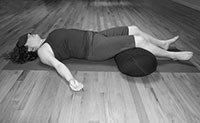 Put a thick yoga mat on the floor and recline on your back. Place the arms at the body’ sides and put a bolster under your knees. Another option is placing a bolster under the upper back with the arms extended to sides. The second option opens the chest, while the first one provides more relaxation to the lower back.
Put a thick yoga mat on the floor and recline on your back. Place the arms at the body’ sides and put a bolster under your knees. Another option is placing a bolster under the upper back with the arms extended to sides. The second option opens the chest, while the first one provides more relaxation to the lower back.
Adho Mukha Svanasana (Supported downward dog)
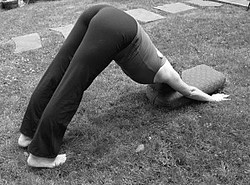 Basically it is the same down ward dog pose, but instead of touching the ground with your head, you put a bolster under it. To come to the pose you need to stand on your hands and knees, keeping both straight, and with your pelvis up. Place your forehead over the pillow and stay in the pose for 1-2 minutes. If you have problems with blood pressure, consult with the doctor before doing the pose (this actually refers to any inversions).
Basically it is the same down ward dog pose, but instead of touching the ground with your head, you put a bolster under it. To come to the pose you need to stand on your hands and knees, keeping both straight, and with your pelvis up. Place your forehead over the pillow and stay in the pose for 1-2 minutes. If you have problems with blood pressure, consult with the doctor before doing the pose (this actually refers to any inversions).
Urdhva Mukha Svanasana (Supported upward dog)
 The Upward dog pose often comes right after the Downward dog pose and acts as a counter pose to the latter. From the Downward dog pose you need to lower your pelvis to the ground, and raise your head along with that. But before doing the pose you need to place a bolster on the floor, at the level of the lower abdomen and hips, so that when your pelvis comes down, the hips and the lower abdomen will rest on the bolster. Look forward and breathe normally. Keep your arms straight and the chest opened.
The Upward dog pose often comes right after the Downward dog pose and acts as a counter pose to the latter. From the Downward dog pose you need to lower your pelvis to the ground, and raise your head along with that. But before doing the pose you need to place a bolster on the floor, at the level of the lower abdomen and hips, so that when your pelvis comes down, the hips and the lower abdomen will rest on the bolster. Look forward and breathe normally. Keep your arms straight and the chest opened.
Balasana (Child’s Pose)
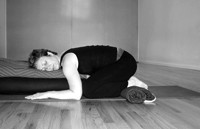 This pose is pretty simple; put a bolster on the floor and kneel in front of it. Pull the bolster a bit to let it sit between your thighs; sit on the heels or between them on the floor, and lean forward to lay your torso down on the bolster. Turn your head to a side (switch the sides after a while) and breathe normally. Try to relax the back, especially the upper back. Remain in the pose as long as you feel comfortable to.
This pose is pretty simple; put a bolster on the floor and kneel in front of it. Pull the bolster a bit to let it sit between your thighs; sit on the heels or between them on the floor, and lean forward to lay your torso down on the bolster. Turn your head to a side (switch the sides after a while) and breathe normally. Try to relax the back, especially the upper back. Remain in the pose as long as you feel comfortable to.
Supta Baddha Konasana (Reclined Cobbler’s Pose)
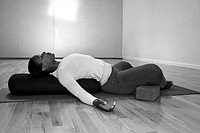 Sit on a yoga mat with legs crossed, and place a bolster behind your back (in a way that you can put the torso and your head on it). Put the soles together, open the knees to the sides, and lean backward, helping yourself with arms. In the final pose, stretch the arms to the sides on the floor, and relax. Use your arms to return to the starting position.
Sit on a yoga mat with legs crossed, and place a bolster behind your back (in a way that you can put the torso and your head on it). Put the soles together, open the knees to the sides, and lean backward, helping yourself with arms. In the final pose, stretch the arms to the sides on the floor, and relax. Use your arms to return to the starting position.
Reclined Twist
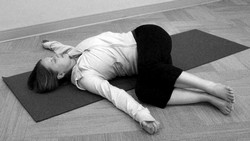 From the Reclined Cobbler’s pose: pull your knees together and place the soles on the floor. Raise your bent legs over the floor, keep your arms stretched to the sides, and with exhale twist them to the right. Stay in the pose for 5-8 full breaths, and then repeat to the left side.
From the Reclined Cobbler’s pose: pull your knees together and place the soles on the floor. Raise your bent legs over the floor, keep your arms stretched to the sides, and with exhale twist them to the right. Stay in the pose for 5-8 full breaths, and then repeat to the left side.
Viparita Karani Mudra (Legs-up-the-Wall Pose)
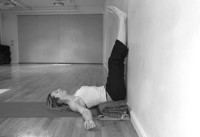 Place your mat against the wall as well as the bolster which is on the mat. Sit on the bolster with your right/left shoulder and hip towards the wall or lay with your pelvis on it; if you are sitting, then turn around in a way to put the torso on the mat and the feet against the wall. If you already laying on the mat on your side, then simply turn over to the back and put your feet against the wall. Inhale, and with exhale, straighten your legs, resting them on the wall; your hips are on the bolster. Stretch your arms apart and relax. Remain in the pose for 2-3 minutes, then bend your legs, turn on your side and stay in this pose for 30 seconds more.
Place your mat against the wall as well as the bolster which is on the mat. Sit on the bolster with your right/left shoulder and hip towards the wall or lay with your pelvis on it; if you are sitting, then turn around in a way to put the torso on the mat and the feet against the wall. If you already laying on the mat on your side, then simply turn over to the back and put your feet against the wall. Inhale, and with exhale, straighten your legs, resting them on the wall; your hips are on the bolster. Stretch your arms apart and relax. Remain in the pose for 2-3 minutes, then bend your legs, turn on your side and stay in this pose for 30 seconds more.
Shavasana (Corpse Pose)
 At the end of your practice do Shavasana again as described before – you need to do it half of the time spent in the Legs-up-the-Wall Pose.
At the end of your practice do Shavasana again as described before – you need to do it half of the time spent in the Legs-up-the-Wall Pose.
These are the simple restorative yoga poses with a bolster – you can do them daily if you want. In case of having a serious health disorder, consult with your doctor before doing these postures.